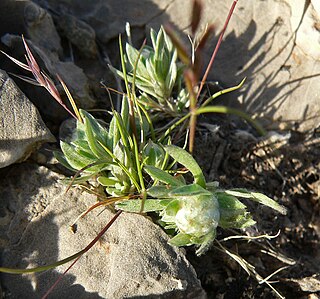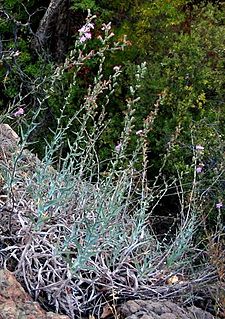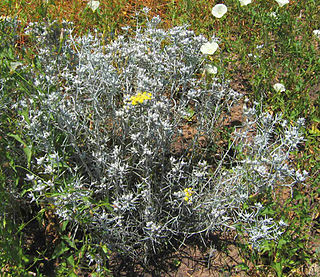
Stylocline(neststraw) is a small genus of North American desert plants in the tribe Gnaphalieae within the family Asteraceae.

Ancistrocarphus is a genus of flowering plants in the family Asteraceae. It contains two known species, both native to western North America. These plants are often treated as members of genus Stylocline, but they are not as closely related to Stylocline species as they are to plants of other genera, especially Hesperevax.
Astragalus austiniae is a species of milkvetch known by the common name Austin's milkvetch. It is native to the Sierra Nevada of California and Nevada in the vicinity of Lake Tahoe. It is a plant of the alpine climate of the high mountains, where it tolerates exposed areas.

Lessingia lemmonii is a species of flowering plant in the daisy family known by the common name Lemmon's lessingia. It is native to the western United States around the intersection of Nevada, Arizona, and California, where it grows in desert and other habitat with sandy soils. This is an annual herb producing gray-green woolly stems in a low clump just a few centimeters high to a relatively erect 40 centimeters tall. The leaves are narrow and small, under 2 centimeters long, with much larger leaves appearing around the base of the young plant and withering away early. The flower heads appear singly or in open arrays. Each head has a bell- to bullet-shaped involucre lined with hairy to woolly phyllaries. The head is discoid, containing no ray florets but many funnel-shaped yellow disc florets with long lobes. The florets often have white markings in the throats. The fruit is an achene with a whitish or brownish pappus of bristles.

Lessingia leptoclada is a species of flowering plant in the daisy family known by the common name Sierra lessingia. It is endemic to the Sierra Nevada of California, where it is known from several types of local habitat. This is a slender annual herb growing erect and varying in size from just a few centimeters to nearly a meter tall, with long, spreading branches. It is very glandular and often hairy or woolly in texture. The upper leaves are up to 5 centimeters long, narrow and sometimes toothed or lobed; the lower leaves are longer and wither early. The flower heads appear singly or in small clusters. Each head is lined with woolly phyllaries. The head is discoid, containing no ray florets but many funnel-shaped pinkish, lavender, or light bluish-purple disc florets with large lobes. The fruit is an achene with a whitish pappus of bristles.
Syntrichopappus is a genus of flowering plants in the family Asteraceae, found in the Southwestern United States and northern Mexico, including Baja California. It is a member of the Heliantheae alliance of the Asteraceae. There are two species. Common names include xerasid and Frémont's-gold.

Psilocarphus brevissimus is a species of flowering plant in the family Asteraceae known by the common names short woollyheads, woolly marbles, and woolly heads.
Psilocarphus elatior is a species of flowering plant in the family Asteraceae known by the common names tall woollyheads, meadow woollyheads and tall woolly-marbles. It is native to the Pacific Northwest in western North America from Vancouver Island, where it is known from just a few occurrences, to northern California. It grows in seasonally moist spots such as meadows, spring seeps, and vernal pools.
Psilocarphus oregonus is a species of flowering plant in the family Asteraceae known by the common names Oregon woollyheads and Oregon woolly marbles. It is native to western North America from Washington and Idaho to Baja California, where it grows in seasonally wet habitat, such as vernal pools.

Psilocarphus tenellus is a species of flowering plant in the family Asteraceae known by the common names slender woollyheads and slender woolly marbles. It is native to western North America from far southwestern British Columbia to Baja California, where it grows in seasonally wet habitat, such as vernal pools, as well as coastline and disturbed areas.

Stephanomeria cichoriacea is a species of flowering plant in the aster family; it is known by the common names chicoryleaf wirelettuce and silver rock-lettuce. It is endemic to California, where it grows in the coastal mountain ranges as far north as Monterey County, but especially in southern California mountains such as the Transverse Ranges. Its habitat includes chaparral. It is a perennial herb producing slender erect stems reaching maximum heights exceeding one meter. The stem is woolly with hairs, especially on new growth. The leaves are mostly located in a basal rosette, the largest reaching 18 to 20 centimeters long. They are lance-shaped and often toothed along the edges, and the newer ones are woolly. Smaller leaves occur farther up the stem. The inflorescence is a long array of several flower heads, with some occurring in the upper leaf axils as well. Each head has a cylindrical base 1 to 2 centimeters long which is lined with layers of glandular phyllaries. The head contains 10 to 15 ray florets, each with an elongated tube and a pink ligule which may be up to 2 centimeters long. The fruit is an achene tipped with a spreading cluster of long, plumelike pappus bristles.
Stylocline citroleum is a rare species of flowering plant in the family Asteraceae known by the common name oil neststraw.
Stylocline intertexta is a species of flowering plant in the family Asteraceae known by the common names Morefield's neststraw and Mojave neststraw. It is native to the Mojave and Sonoran Deserts of California, Nevada, Utah, and Arizona, where it grows in rocky, sandy desert soils. It likely evolved as a hybrid between woollyhead neststraw and baretwig neststraw ; it is a mix of their morphological traits and it occurs alongside both of them. It reproduces itself, producing fertile offspring, and it meets other criteria for any other definition of a species, so it was described to science as such in 1992. It is a small annual herb growing at ground level and reaching just a few centimeters in length. It is usually coated in white hairs, often woolly. The small, pointed leaves are oval to lance-shaped and measure up to 1.5 centimeters long. The inflorescence bears spherical flower heads each a few millimeters in diameter. The head has no phyllaries, just a ball of tiny woolly white flowers.
Stylocline masonii is an uncommon species of flowering plant in the family Asteraceae known by the common name Mason's neststraw.

Stylocline micropoides is a species of flowering plant in the family Asteraceae known by the common names woollyhead neststraw, woollyhead fanbract and desert neststraw. It is native to the southwestern United States and northern areas in the northern states of Mexico, where it grows in desert habitat and other dry areas. It is a small annual herb growing at ground level with stems up to 20 centimeters in length. It is woolly or felt-like in texture with a coating of white hairs. The pointed leaves are up to 2 centimeters long and alternately arranged. The inflorescence bears spherical flower heads no more than a centimeter in diameter. The head generally has no phyllaries, or has small ones that fall away early. It contains several woolly white flowers.

Stylocline psilocarphoides is a species of flowering plant in the family Asteraceae known by the common names baretwig neststraw and Peck's neststraw. It is native to the western United States from Idaho to southeastern California, where it grows in deserts and other dry, sandy, gravelly habitat. It is a small annual herb growing at ground level with stems measuring 1 to 18 centimeters in length. It is woolly or felt-like in texture with a coating of white hairs. The pointed leaves are up to 1.8 centimeters long and alternately arranged. The inflorescence bears oval flower heads no more than half a centimeter in diameter. The head generally has no phyllaries, or has small ones that fall away early. It is a hardened ball of several woolly white flowers.
Tetradymia argyraea is a species of flowering plant in the aster family known by the common names striped cottonthorn and striped horsebrush. It is native to the desert mountains of the southwestern United States, particularly of California, Nevada, and Arizona, where it grows in desert woodland habitat. It is a woolly, spiny shrub growing one half to nearly two meters in maximum height. The erect stems are white-woolly except for bare stripes at intervals. The leaves are linear in shape and harden as they age, becoming spiny. The larger leaves are woolly and there are clusters of smaller, threadlike leaves which may be hairless. The inflorescence bears two to five flower heads which are each enveloped in five thick phyllaries coated in white woolly hairs. Each head contains five pale yellow flowers each around a centimeter long. Flowers are produced in summer, as late as September. The fruit is an achene a few millimeters long tipped with a pappus of bristles.

Tetradymia comosa is a species of flowering plant in the aster family, known by the common name hairy horsebrush.

Tricardia is a monotypic genus of flowering plants in the borage family containing the single species Tricardia watsonii, which is known by the common name threehearts. It is native to the southwestern United States, where it grows in deserts and mountains in sandy open habitat, often beneath shrubs. It is a perennial herb growing from a taproot and a woody caudex covered with the shreddy remains of previous seasons' herbage. It produces several erect stems up to about 40 centimeters tall. Most of the leaves are located in a basal rosette about the caudex. They are lance-shaped and coated thinly in woolly hairs. They are up to 9 centimeters long and are borne on petioles. A few smaller leaves occur higher on the stem. Flowers occur in a loose cyme at the top of the stem. Each has a calyx of five sepals. The outer three are heart-shaped and green to pink or purple in color, and the inner two are much smaller and narrower. The flower within is bell-shaped, white with central purple markings, and roughly half a centimeter wide. The fruit is a capsule just under a centimeter long which contains 4 to 8 seeds.

Ancistrocarphus filagineus is a North American species of flowering plants in the family Asteraceae, known by the common names woolly fishhooks and hooked groundstar. It is native to western North America, including Idaho, Oregon, Nevada, California, and Baja California.











